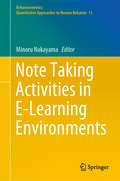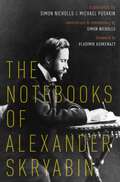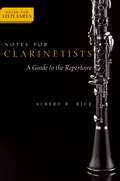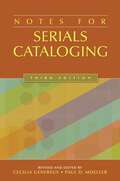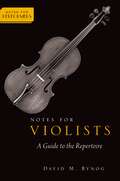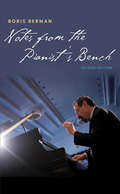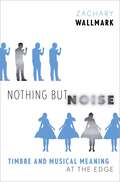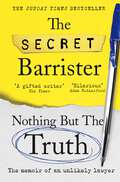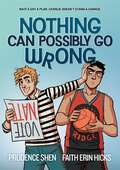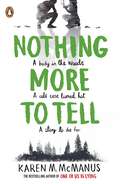- Table View
- List View
Notable Books, Notable Lessons: Putting Social Studies Back in the K-8 Curriculum
by Andrea S. Libresco Jeannette Balantic Mary BattenfeldThis book provides teachers, librarians, and education methods professors with strategies, lesson plans, and activities that enable them to use literature as a springboard to social studies thematic instruction.With the amount of time and resources allocated to teaching social studies being significantly reduced, social studies lessons need to be incorporated into other subjects. Notable Books, Notable Lessons: Putting Social Studies Back in the K–8 Curriculum offers the tools to teach students social studies concepts that are increasingly relevant and essential in today's diverse, globalized world—lessons that are vital in order to prepare students to think critically and participate in our multicultural democracy.Providing information that elementary and middle school teachers and librarians, district-level curriculum directors and principals, staff developers, and social studies and literacy methods professors will find extremely useful, this book uses the National Council for the Social Studies (NCSS)/Children's Book Council (CBC)'s current and past lists of Notable Books at the elementary and middle school levels to offer easy-to-follow lesson plans that integrate social studies instruction with reading and language arts. The lesson plans pose compelling questions to facilitate discussion and critical thinking and suggest engaging activities that are connected to the social studies concepts. The book also includes sample student handouts for the selected pieces of literature.
Note Taking Activities in E-Learning Environments (Behaviormetrics: Quantitative Approaches to Human Behavior #11)
by Minoru NakayamaThe main focus of this book is presenting practical procedures for improving learning effectiveness using note taking activities during e-learning courses. Although presentation of e-learning activities recently has been spreading to various education sectors, some practical problems have been discussed such as evaluation of learning performance and encouragement of students. The authors introduce note taking activity as a conventional learning tool in order to promote individual learning activity and learning efficacy. The effectiveness of note taking has been measured in practical teaching in a Japanese university using techniques of learning analytics, and the results are shown here. The relationships between note taking activity and students’ characteristics, the possibility of predicting the final learning performance using metrics of students’ note taking, and the effectiveness for individual emotional learning factors are evaluated. Some differences between blended learning and fully online learning courses are also discussed. The authors provide novel analytical procedures and ideas to manage e-learning courses. In particular, the assessment of note taking activity may help to track individual learning progress and to encourage learning motivation.
Notebook Connections: Strategies for the Reader's Notebook
by Aimee BucknerIn Notebook Connections: Strategies for the Reader's Notebook , author Aimee Buckner focuses on the reading workshop and how teachers can transform students from couch potato- readers who read and answer basic questions about a text to readers who critically think beyond their reading. Buckner's fourth grade students use reader's notebooks as a place to document their thinking about a text and explore ideas without every entry being judged or graded as evidence of their reading progress. Buckner describes her model as flexible enough for students to respond in a variety of ways yet structured enough to provide explicit instruction. Inside Notebook Connections, you'll find: Ways to launch, develop, and fine-tune a reader's notebook program Teacher-guided lessons for each chapter Assessment tips to review student growth and comprehension levels How to select the strategies that work for them and incorporate into the workshop Notebook Connections provides a comprehensive model for making reader's notebooks the centerpiece of your reading workshop. Reader's notebooks become a bridge that helps students make connections between ideas, texts, strategies, and their work as readers and writers.
Notebook Connections: Strategies for the Reader's Notebook
by Aimee BucknerIn Notebook Connections: Strategies for the Reader's Notebook , author Aimee Buckner focuses on the reading workshop and how teachers can transform students from couch potato- readers who read and answer basic questions about a text to readers who critically think beyond their reading. Buckner's fourth grade students use reader's notebooks as a place to document their thinking about a text and explore ideas without every entry being judged or graded as evidence of their reading progress. Buckner describes her model as flexible enough for students to respond in a variety of ways yet structured enough to provide explicit instruction. Inside Notebook Connections, you'll find: Ways to launch, develop, and fine-tune a reader's notebook program Teacher-guided lessons for each chapter Assessment tips to review student growth and comprehension levels How to select the strategies that work for them and incorporate into the workshop Notebook Connections provides a comprehensive model for making reader's notebooks the centerpiece of your reading workshop. Reader's notebooks become a bridge that helps students make connections between ideas, texts, strategies, and their work as readers and writers.
The Notebooks of Alexander Skryabin
by Simon NichollsRussian composer Alexander Skryabin's life spanned the late romantic era and the momentous early years of the twentieth century, but was cut short before the end of the first world war. In a predominantly conservative era in the Russian musical scene, he drew inspiration from poets, philosophers, and dramatists of the Silver Age, a period of radical artistic renewal in Russia. Possessed by an apocalyptic vision of transformation, aspects of which he shared with other Russian thinkers and artists of the period, Skryabin transformed his musical language from a ripe Romantic style into a far-reaching, radical instrument for the expression of his ideas. This newly translated collection of the composer's writings and letters allows readers to experience and understand Skryabin's worldview, personality, and life as never before. The Notebooks of Alexander Skryabin features commentary based on original materials and accounts by the composer's friends and associates, dispelling popular misconceptions about his life and revealing the dazzling constellation of philosophies that comprised his world of ideas, from Ancient Greek and German Idealist philosophy to the writings of Nietzsche, and Indian culture to the Theosophical writings of H. P. Blavatsky. Close textual readings and new biographical insights converge to present a vivid impression of Skryabin's thought and its impact on his musical compositions.
The Notebooks of Alexander Skryabin
by Simon NichollsRussian composer Alexander Skryabin's life spanned the late romantic era and the momentous early years of the twentieth century, but was cut short before the end of the first world war. In a predominantly conservative era in the Russian musical scene, he drew inspiration from poets, philosophers, and dramatists of the Silver Age, a period of radical artistic renewal in Russia. Possessed by an apocalyptic vision of transformation, aspects of which he shared with other Russian thinkers and artists of the period, Skryabin transformed his musical language from a ripe Romantic style into a far-reaching, radical instrument for the expression of his ideas. This newly translated collection of the composer's writings and letters allows readers to experience and understand Skryabin's worldview, personality, and life as never before. The Notebooks of Alexander Skryabin features commentary based on original materials and accounts by the composer's friends and associates, dispelling popular misconceptions about his life and revealing the dazzling constellation of philosophies that comprised his world of ideas, from Ancient Greek and German Idealist philosophy to the writings of Nietzsche, and Indian culture to the Theosophical writings of H. P. Blavatsky. Close textual readings and new biographical insights converge to present a vivid impression of Skryabin's thought and its impact on his musical compositions.
Noten an Deutschlands Hochschulen: Analysen zur Vergleichbarkeit von Examensnoten 1960 bis 2013
by Volker Müller-Benedict Gerd GrözingerIn diesem Buch werden die langfristigen Verläufe – 1960 bis 2013 – der Examensnoten für zentrale Fächer und viele Hochschulen dargestellt und die Ursachen für ihre Nicht-Vergleichbarkeit analysiert. Im Fokus stehen die Bestimmung nicht-leistungsbedingter Einflüsse sowie die Erklärung von ‚grade inflation‘, also die Ursachen für eine Verbesserung der Noten ohne eine gleichwertige Verbesserung der Prüfungsleistungen.
Notes for Cellists: A Guide to the Repertoire (Notes for Performers)
by Miranda WilsonNotes for Cellists: A Guide to the Repertoire is an essential resource for anyone seeking to enrich their understanding of cello music. Written by cellist and cello professor Miranda Wilson, this book explores the world of cello repertoire with analytical overviews and background information on compositions spanning five centuries. In an engaging and accessible style, Notes for Cellists guides readers through the repertoire, providing detailed insights into the lives of composers and the cellists who inspired them. From Bach and Beethoven to contemporary works by living composers, Notes for Cellists offers historical and analytical contexts for over three dozen works. Whether you're a student, professional, teacher, college faculty member, amateur player, or simply an enthusiast of the cello, Notes for Cellists is an indispensable tool. With extended program notes on the essentials of cello repertoire, this book serves as a guide for reference or a starting point for further research.
Notes for Cellists: A Guide to the Repertoire (Notes for Performers)
by Miranda WilsonNotes for Cellists: A Guide to the Repertoire is an essential resource for anyone seeking to enrich their understanding of cello music. Written by cellist and cello professor Miranda Wilson, this book explores the world of cello repertoire with analytical overviews and background information on compositions spanning five centuries. In an engaging and accessible style, Notes for Cellists guides readers through the repertoire, providing detailed insights into the lives of composers and the cellists who inspired them. From Bach and Beethoven to contemporary works by living composers, Notes for Cellists offers historical and analytical contexts for over three dozen works. Whether you're a student, professional, teacher, college faculty member, amateur player, or simply an enthusiast of the cello, Notes for Cellists is an indispensable tool. With extended program notes on the essentials of cello repertoire, this book serves as a guide for reference or a starting point for further research.
Notes for Clarinetists: A Guide to the Repertoire (Notes for Performers)
by Albert R. RiceNotes for Clarinetists: A Guide to the Repertoire offers important historical and analytical information about thirty-five of the best-known pieces written for the instrument. Numerous contextual and theoretical insights make it an essential resource for professional, amateur, and student clarinetists. With engaging prose supported by fact-filled analytical charts, the book offers rich biographical information and informative analyses to help clarinetists gain a more complete understanding of Three Pieces for Clarinet Solo by Igor Stravinsky, Aaron Copland's Concerto for Clarinet, String Orchestra, Harp, and Piano, Robert Schumann's Fantasy Pieces for Clarinet and Piano, Op. 73. and Time Pieces for Clarinet and Piano, Op. 43. by Robert Muczynski, among many others. With close attention to matters of context, style, and harmonic and formal analysis, Albert Rice explores a significant portion of the repertoire, and offers a faithful and comprehensive guide that includes works by Boulez, Brahms, and Mozart to Hindemith, Poulenc, and Stamitz. Rice includes biographical information on each composer and highlights history's impact on the creation and performance of important works for clarinet. Intended as a starting point for connecting performance studies with scholarship, Rice's analysis will help clarinetists gain a more complete picture of a given work. Its valuable insights make it essential to musicians preparing and presenting programs, and its detailed historical information about the work and composer will encourage readers to explore other works in a similarly analytical way. Covering concertos, chamber pieces, and works for solo clarinet, Rice presents Notes for Clarinetists as an indispensable handbook for students and professionals alike.
Notes for Clarinetists: A Guide to the Repertoire (Notes for Performers)
by Albert R. RiceNotes for Clarinetists: A Guide to the Repertoire offers important historical and analytical information about thirty-five of the best-known pieces written for the instrument. Numerous contextual and theoretical insights make it an essential resource for professional, amateur, and student clarinetists. With engaging prose supported by fact-filled analytical charts, the book offers rich biographical information and informative analyses to help clarinetists gain a more complete understanding of Three Pieces for Clarinet Solo by Igor Stravinsky, Aaron Copland's Concerto for Clarinet, String Orchestra, Harp, and Piano, Robert Schumann's Fantasy Pieces for Clarinet and Piano, Op. 73. and Time Pieces for Clarinet and Piano, Op. 43. by Robert Muczynski, among many others. With close attention to matters of context, style, and harmonic and formal analysis, Albert Rice explores a significant portion of the repertoire, and offers a faithful and comprehensive guide that includes works by Boulez, Brahms, and Mozart to Hindemith, Poulenc, and Stamitz. Rice includes biographical information on each composer and highlights history's impact on the creation and performance of important works for clarinet. Intended as a starting point for connecting performance studies with scholarship, Rice's analysis will help clarinetists gain a more complete picture of a given work. Its valuable insights make it essential to musicians preparing and presenting programs, and its detailed historical information about the work and composer will encourage readers to explore other works in a similarly analytical way. Covering concertos, chamber pieces, and works for solo clarinet, Rice presents Notes for Clarinetists as an indispensable handbook for students and professionals alike.
Notes for Serials Cataloging
The last decade has brought a great deal of change to serials and to scholarly communication as a whole. Serials have gone online or online only with a rapidness few expected; and many libraries now spend half or more of their materials budgets on electronic journals. Arranged in MARC tag order and by topical subdivision, the latest edition of Notes for Serials Cataloging is designed to help both novice and experienced serials catalogers describe the complex characteristics and relationships of serial publications and construct clear and concise notes. In addition to updated definitions, scope notes, and examples of notes presented in previous editions, it incorporates notes used in electronic serials cataloging as well as covers changing practices in MARC note field usage in keeping with CONSER standards.
Notes for Violists: A Guide to the Repertoire (Notes for Performers)
by David M. BynogNotes for Violists: A Guide to the Repertoire offers historical and analytical information about thirty-five of the best-known pieces for the instrument, making it an essential resource for professional, amateur, and student violists alike. With engaging prose supported by fact-filled analytical charts, the book offers rich biographical information and insightful analyses that help violists gain a more complete understanding of pieces like Béla Bartók's Concerto for Viola and Orchestra, Rebecca Clarke's Sonata for Viola and Piano, Robert Schumann's Märchenbilder for Viola and Piano, op. 113, Carl Stamitz's Concerto for Viola and Orchestra in D Major, Igor Stravinsky's Élégie for Viola or Violin Unaccompanied, and thirty other masterpieces. This comprehensive guide to key pieces from the viola repertoire from the eighteenth through the twentieth century covers concertos, chamber pieces, and works for solo viola by a wide range of composers, including Bach, Telemann, Mozart, Hoffmeister, Walton, and Hindemith. Author David M. Bynog not only offers clear structural analyses of these compositions but also situates them in their historical contexts as he highlights crucial biographical information on composers and explores the circumstances of the development and performance of each work. By connecting performance studies with scholarship, this indispensable handbook for students and professionals allows readers to gain a more complete picture of each work and encourages them to approach other compositions in a similarly analytical manner.
Notes for Violists: A Guide to the Repertoire (Notes for Performers)
by David M. BynogNotes for Violists: A Guide to the Repertoire offers historical and analytical information about thirty-five of the best-known pieces for the instrument, making it an essential resource for professional, amateur, and student violists alike. With engaging prose supported by fact-filled analytical charts, the book offers rich biographical information and insightful analyses that help violists gain a more complete understanding of pieces like Béla Bartók's Concerto for Viola and Orchestra, Rebecca Clarke's Sonata for Viola and Piano, Robert Schumann's Märchenbilder for Viola and Piano, op. 113, Carl Stamitz's Concerto for Viola and Orchestra in D Major, Igor Stravinsky's Élégie for Viola or Violin Unaccompanied, and thirty other masterpieces. This comprehensive guide to key pieces from the viola repertoire from the eighteenth through the twentieth century covers concertos, chamber pieces, and works for solo viola by a wide range of composers, including Bach, Telemann, Mozart, Hoffmeister, Walton, and Hindemith. Author David M. Bynog not only offers clear structural analyses of these compositions but also situates them in their historical contexts as he highlights crucial biographical information on composers and explores the circumstances of the development and performance of each work. By connecting performance studies with scholarship, this indispensable handbook for students and professionals allows readers to gain a more complete picture of each work and encourages them to approach other compositions in a similarly analytical manner.
Notes from the Margins: The Gay Analyst's Subjectivity in the Treatment Setting
by Eric ShermanMuch has been written about the impact of gender and sexual orientation on the intersubjective field. Yet remarkably little has been written about the unique dilemmas faced by gay clinicians who treat patients of different genders and sexual orientations. Given the particularities of growing up gay in our culture, issues of secrecy, shame, alienation, difference, and internalized homophobia necessarily enter into any gay therapist's developmental history. These factors have a shaping impact on the gay analyst's sensibility, on the way he learns to listen to his patients. In Notes from the Margins, Eric Sherman courageously reveals a wide range of subjective reactions to eight different patients. In detailed clinical vignettes that highlight his thoughts, feelings, personal history, and countertransference struggles, he conveys the experiential immediacy of working as an analyst-and, more specifically, as a gay analyst. Although Sherman is not the first author to write thoughtfully about working in the countertransference, he is among the very few to portray analytic work, particularly in the working through of enactments, as an often untidy affair, marked not only by success but also by the blind spots and insecurities that contribute to failure. Notes from the Margins is not only an illuminating overview of the special challenges faced by gay and lesbian analysts, but a window to grasping the messy realities intrinsic to the psychotherapeutic process.
Notes from the Margins: The Gay Analyst's Subjectivity in the Treatment Setting
by Eric ShermanMuch has been written about the impact of gender and sexual orientation on the intersubjective field. Yet remarkably little has been written about the unique dilemmas faced by gay clinicians who treat patients of different genders and sexual orientations. Given the particularities of growing up gay in our culture, issues of secrecy, shame, alienation, difference, and internalized homophobia necessarily enter into any gay therapist's developmental history. These factors have a shaping impact on the gay analyst's sensibility, on the way he learns to listen to his patients. In Notes from the Margins, Eric Sherman courageously reveals a wide range of subjective reactions to eight different patients. In detailed clinical vignettes that highlight his thoughts, feelings, personal history, and countertransference struggles, he conveys the experiential immediacy of working as an analyst-and, more specifically, as a gay analyst. Although Sherman is not the first author to write thoughtfully about working in the countertransference, he is among the very few to portray analytic work, particularly in the working through of enactments, as an often untidy affair, marked not only by success but also by the blind spots and insecurities that contribute to failure. Notes from the Margins is not only an illuminating overview of the special challenges faced by gay and lesbian analysts, but a window to grasping the messy realities intrinsic to the psychotherapeutic process.
Notes from the Pianist's Bench: Second Edition, Multimedia Edition
by Boris BermanA master class on piano performance and pedagogy from the world-renowned concert pianist In this newly revised edition of a comprehensive guide to piano technique, performance, and music interpretation, renowned performing musician, recording artist, and teacher Boris Berman addresses virtually every aspect of musical artistry and pedagogy. Ranging from such practical matters as sound, touch, and pedaling to the psychology of performing and teaching, this essential volume provides a master class for the performer, instructor, and student alike. It is also available as a multimedia e-Book.
Nothing but Noise: Timbre and Musical Meaning at the Edge
by Zachary WallmarkNothing but Noise: Timbre and Musical Meaning at the Edge explores how timbre shapes musical affect and meaning. Integrating perspectives from musicology with the cognitive sciences, author Zachary Wallmark advances a novel model of timbre interpretation that takes into account the bodily, sensorimotor dynamics of sound production and perception. The contribution of timbre to musical experience is clearest in drastic situations where meaning is itself contested; that is, in polarizing contexts of reception where evaluation of "musical" timbre by some listeners collides headlong against a competing claim-that it is just "noise." Taking this ubiquitous moment as a starting point, the book explores affect, reception, and timbre semantics through diverse cultural-historical case studies that frustrate the acoustic and perceptual boundary between musical sound and noise. Nothing but Noise includes chapters on the racial and gender politics in the reception of free jazz saxophone "screaming" in the late 1960s; an analysis of contested timbral ideals in the performance practices of the Japanese shakuhachi flute; and an historical examination of the overlooked role of "brutal" timbres in the moral panic over heavy metal in the eighties and nineties. The book closes with a discussion of the slippery social fault lines separating perceptions of musical sound from noise and the ethical stakes of encountering another's "aural face."
Nothing but Noise: Timbre and Musical Meaning at the Edge
by Zachary WallmarkNothing but Noise: Timbre and Musical Meaning at the Edge explores how timbre shapes musical affect and meaning. Integrating perspectives from musicology with the cognitive sciences, author Zachary Wallmark advances a novel model of timbre interpretation that takes into account the bodily, sensorimotor dynamics of sound production and perception. The contribution of timbre to musical experience is clearest in drastic situations where meaning is itself contested; that is, in polarizing contexts of reception where evaluation of "musical" timbre by some listeners collides headlong against a competing claim-that it is just "noise." Taking this ubiquitous moment as a starting point, the book explores affect, reception, and timbre semantics through diverse cultural-historical case studies that frustrate the acoustic and perceptual boundary between musical sound and noise. Nothing but Noise includes chapters on the racial and gender politics in the reception of free jazz saxophone "screaming" in the late 1960s; an analysis of contested timbral ideals in the performance practices of the Japanese shakuhachi flute; and an historical examination of the overlooked role of "brutal" timbres in the moral panic over heavy metal in the eighties and nineties. The book closes with a discussion of the slippery social fault lines separating perceptions of musical sound from noise and the ethical stakes of encountering another's "aural face."
Nothing But The Truth: Stories of Crime, Guilt and the Loss of Innocence
by The Secret BarristerA memoir full of hilarious, personal and surprising stories from their working life, this is the brilliant Secret Barrister at their very best.__________Just how do you become a barrister? Why do only 1 per cent of those who study law succeed in joining this mysteriously opaque profession? And why might a practising barrister come to feel the need to reveal the lies, secrets, failures and crises at the heart of this world of wigs and gowns?Nothing But The Truth charts an outsider’s progress down the winding path towards practising at the Bar, taking in the sometimes absurd traditions of the Inns of Court, where every meal mandates a glass of port and a toast to the Queen, to the Hunger Games-type contest for pupillage, through the endlessly frustrating experience of being a junior barrister – as a creaking, ailing justice system begins to convince them that something has to change . . .Full of hilarious, shocking and surprising stories, Nothing But The Truth tracks the Secret Barrister’s transformation from hang ‘em and flog ‘em, austerity-supporting twenty-something to campaigning, bestselling, reforming author whose writing in defence of the law is celebrated around the globe. It asks questions about what we understand by justice, and what it takes to change our minds. It also reveals the darker side of working in criminal law, and how the things our justice system gets wrong are not the things most people expect.__________PRAISE FOR THE SECRET BARRISTER:‘Dishes the dirt — or serves up a slice of reality — on what barristers do’ - The Times‘An illuminating and timely insight into the legal system . . . fascinating’ - Sunday Express‘Excellent . . . at once a vicious polemic, a helpful primer and a cringe-inducing account of one barrister’s travails’ - Daily Telegraph
Nothing Can Possibly Go Wrong: A Funny YA Graphic Novel about Unlikely friendships, Rivalries and Robots
by Prudence ShenNothing Can Possibly Go Wrong is an unmissable heartfelt and hilarious YA graphic novel featuring two unlikely friends, by the New York Times bestselling Faith Erin Hicks and Prudence Shen, perfect for fans of Heartstopper!You wouldn't expect Nate and Charlie to be friends.Charlie’s the laid-back captain of the basketball team. Nate is the neurotic, scheming president of the robotics club. But they are friends, however unlikely – until Nate declares war on the cheerleaders and the cheerleaders retaliate by making Charlie their figurehead in the ugliest class election campaign the school has ever seen. At stake? Student group funding that will either cover a robotics competition or new cheerleading uniforms, but not both.Bad sportsmanship? Sure. Dangerous machinery? Why not. Running away from home on Thanksgiving to illicitly enter a televised robot deathmatch? Let's do this!With black and white inside illustrations, this is a feel-good YA graphic novel about unlikely friends, rivalries, relationships and robotics. Don't miss Faith's other YA graphic novels: Hockey Girl Loves Drama Boy, One Year at Ellsmere, Friends With Boys and Pumpkinheads (with Rainbow Rowell).
Nothing More to Tell: The new release from bestselling author Karen McManus
by Karen M. McManusFrom the internationally bestselling author of Netflix's hottest new show, One of Us is Lying, comes a new, page-turning thriller . . .True crime can leave a false trail.Four years ago, Brynn left Saint Ambrose School following the shocking murder of her favourite teacher. The case was never solved, but she's sure that the three kids who found Mr. Larkin's body know more than they're telling, especially her ex-best friend Tripp Talbot. He's definitely hiding something.When Brynn gets an internship working on a popular true-crime show, she decides to investigate what really happened that day in the woods. But the further she dives into the past, the more secrets she finds.Four years ago someone got away with murder. Now it's time to uncover the truth . . .'Given that her high-school-based murder mysteries read like bingeworthy Netflix dramas, it's easy to see why queen of teen crime Karen McManus is a bestseller on both sides of the Atlantic' - Observer
Nothing Succeeds Like Failure: The Sad History of American Business Schools (Histories of American Education)
by Steven ConnDo business schools actually make good on their promises of "innovative," "outside-the-box" thinking to train business leaders who will put society ahead of money-making? Do they help society by making better business leaders? No, they don't, Steven Conn asserts, and what's more they never have. In throwing down a gauntlet on the business of business schools, Conn's Nothing Succeeds Like Failure examines the frictions, conflicts, and contradictions at the heart of these enterprises and details the way business schools have failed to resolve them. Beginning with founding of the Wharton School in 1881, Conn measures these schools' aspirations against their actual accomplishments and tells the full and disappointing history of missed opportunities, unmet aspirations, and educational mistakes. Conn then poses a set of crucial questions about the role and function of American business schools. The results aren't pretty. Posing a set of crucial questions about the function of American business schools, Nothing Succeeds Like Failure is pugnacious and controversial. Deeply researched and fun to read, Nothing Succeeds Like Failure argues that the impressive façades of business school buildings resemble nothing so much as collegiate versions of Oz. Conn pulls back the curtain to reveal a story of failure to meet the expectations of the public, their missions, their graduates, and their own lofty aspirations of producing moral and ethical business leaders.
Nourishing Caregiver Collaborations: Elevating Home Experiences and Classroom Practices for Collective Care
by Nawal QarooniIn Nourishing Caregiver Collaborations: Elevating Home Experiences and Classroom Practices for Collective Care, Nawal Qarooni invites us to step beyond school-centric, one-off events and practices to create more authentic, engaging collaborations with caregivers. Instead of asking what families can do to support schools, Qarooni asks how schools can identify and celebrate what families already inherently bring to their children’s literacy learning. Establishing this work in holistic teaching—a pedagogical mindset that affirms the importance of loving the whole child through compassionate, collective care—Qarooni explores five critical literacy tenets by highlighting opportunities to listen for, honor, connect to, and elevate family strengths while inviting them even further into our shared work and encouraging reflection around: Recognizing the journey of process, Celebrating the role collaboration plays within the collective Using observational literacy to read the world Advocating for the power of talk to grow ideas and connect with others Giving children choice to make self-directed decisions With moments of memoir woven in alongside diverse family examples and classroom stories connected to realistic instructional practices, Qarooni shows how all families contribute meaningfully to their children’s literacy lives. Discover how we can tap into those vast wells to support learning at home and in school while building positive, reciprocal relationships across both settings. With an afterword by En Comunidad authors, Carla España and Luz Yadira Herrera, Nourishing Caregiver Collaborations is rooted in the simple truth that we cannot separate knowing our students from knowing their home, communities, and the people that they love. This book offers a toolkit for connecting with families and elevating the intrinsic strengths that reside in every child’s home.
Nourishing Caregiver Collaborations: Elevating Home Experiences and Classroom Practices for Collective Care
by Nawal QarooniIn Nourishing Caregiver Collaborations: Elevating Home Experiences and Classroom Practices for Collective Care, Nawal Qarooni invites us to step beyond school-centric, one-off events and practices to create more authentic, engaging collaborations with caregivers. Instead of asking what families can do to support schools, Qarooni asks how schools can identify and celebrate what families already inherently bring to their children’s literacy learning. Establishing this work in holistic teaching—a pedagogical mindset that affirms the importance of loving the whole child through compassionate, collective care—Qarooni explores five critical literacy tenets by highlighting opportunities to listen for, honor, connect to, and elevate family strengths while inviting them even further into our shared work and encouraging reflection around: Recognizing the journey of process, Celebrating the role collaboration plays within the collective Using observational literacy to read the world Advocating for the power of talk to grow ideas and connect with others Giving children choice to make self-directed decisions With moments of memoir woven in alongside diverse family examples and classroom stories connected to realistic instructional practices, Qarooni shows how all families contribute meaningfully to their children’s literacy lives. Discover how we can tap into those vast wells to support learning at home and in school while building positive, reciprocal relationships across both settings. With an afterword by En Comunidad authors, Carla España and Luz Yadira Herrera, Nourishing Caregiver Collaborations is rooted in the simple truth that we cannot separate knowing our students from knowing their home, communities, and the people that they love. This book offers a toolkit for connecting with families and elevating the intrinsic strengths that reside in every child’s home.

